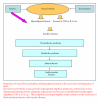Hypoadiponectinemia: A Link between Visceral Obesity and Metabolic Syndrome
- PMID: 22013516
- PMCID: PMC3195429
- DOI: 10.1155/2012/175245
Hypoadiponectinemia: A Link between Visceral Obesity and Metabolic Syndrome
Abstract
Metabolic syndrome (MetS) represents a combination of cardiometabolic risk factors, including visceral obesity, glucose intolerance or type 2 diabetes, elevated triglycerides, reduced HDL cholesterol, and hypertension. MetS is rapidly increasing in prevalence worldwide as a consequence of the "epidemic" obesity, with a considerable impact on the global incidence of cardiovascular disease and type 2 diabetes. At present, there is a growing interest on the role of visceral fat accumulation in the occurrence of MetS. In this review, the effects of adipocytokines and other proinflammatory factors produced by fat accumulation on the occurrence of the MetS have been also emphasized. Accordingly, the "hypoadiponectinemia" has been proposed as the most interesting new hypothesis to explain the pathophysiology of MetS.
Figures
References
-
- Avogaro P, Crepaldi G. Essential hyperlipidemia, obesity and diabetes. Diabetologia. 1965;1:p. 137.
-
- Reaven GM. Banting lecture: role of insulin resistance in human disease. Diabetes. 1988;37(12):1595–607. - PubMed
-
- Kaplan NM. The deadly quartet: upper-body obesity, glucose intolerance, hypertriglyceridemia, and hypertension. Archives of Internal Medicine. 1989;149(7):1514–1520. - PubMed
-
- Definition and classification of diabetes mellitus and its complications. Report of a WHO document. WHO/NCD/NCS/99.2. 1999:31–33.
-
- Balkau B, Charles MA. Comment on the provisional report from the WHO consultation. European Group for the Study of Insulin Resistance (EGIR) Diabetic Medicine. 1999;16(5):442–443. - PubMed
LinkOut - more resources
Full Text Sources



